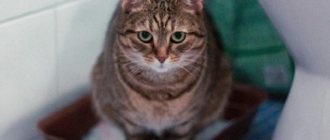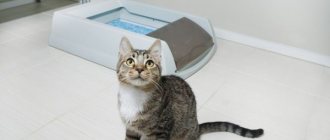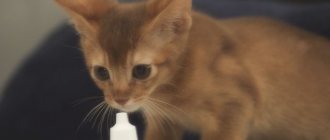Raising pets is often compared to raising children. They also cannot talk about their problems, so the owners have to independently monitor their well-being and notice any changes in behavior.
Pets under one year of age need special attention; due to their age, they are at risk and are very susceptible to illnesses and other disorders. Below you can find out what to do if your kitten doesn't go to the toilet all day - and how to prevent constipation in babies.
How to tell if a small kitten is not going to the toilet in a big way
For the first month after birth, the cubs are cared for by their mother. She licks feces and urine, so their absence at this stage is not significant. Despite this, an attentive owner can still understand when an older little kitten cannot go to the toilet. The following symptoms will indicate constipation:
- loss of appetite and weight loss;
- lethargy and loud squeaking (during defecation and at rest);
- refusing to go to the litter box and urinating in inappropriate places;
- change in the consistency (dryness, hardness) of stool and the appearance of foreign inclusions in it (mucus, blood);
- compaction and bloating of the abdomen, as well as discomfort when palpating;
- prolonged and unsuccessful sitting in the tray, leading to swelling of the anus.
It is equally important to consider the duration of absence of bowel movement. Its recommended frequency depends on the age of the animal.
Normal for kittens of different ages
Adult animals defecate once a day, and older animals defecate once every 2 or even 3 days. This is due to the deterioration of intestinal motility with aging. In babies, it works like a clock, so the frequency of bowel movements in the first week of life reaches 12 times a day.
Breastfed
Feeding strictly on mother's milk lasts until the appearance of the first teeth - the baby incisors. They erupt 2-3 weeks after birth. Until this point, the cubs eat 8-12 times a day and go to the toilet after each feeding.
When feeding
After introducing complementary foods, newborns' loose stools take on a more dense form. Intestinal microflora finishes forming by about 1 month. Babies no longer require stimulation of the tummy with the mother's tongue, and the frequency of their bowel movements is reduced to 6 times a day.
Fully aft
Complete transfer to food occurs after breastfeeding stops, that is, at 2.5-3 months. At this stage, the pet goes to the toilet 2-3 times, and after reaching six months - only 1 time, like a real adult.
Changing your diet
A sudden change from one diet to another can lead to digestive upset in a kitten - this can be expressed either by diarrhea or constipation. Therefore, in the first week after purchase, it is advisable to feed the pet in the same way as the breeder did. Good breeders usually pay a lot of attention to this issue and often give new owners a supply of food for several days. Often, owners try to feed the kitten home-cooked food, but it all ends with the kitten eating only boiled or even raw meat and boiled eggs, and such a diet not only does not meet the nutritional needs of the kitten’s growing body, but also leads to constipation.
Non-hazardous reasons
If a kitten doesn’t go to the toilet regularly for only 1 day, and its general health does not cause concern, then the likelihood of pathology is minimal. In this case, you should observe, since the most banal explanation is relieving yourself in a secluded place.
He walks, but in a secluded place
At the stage of litter box training, it is very important to determine the correct place. Listen to your pet. An area that is too open and noisy will cause discomfort and force you to look for more private places - under the sofa or behind the bed.
If the “mustache” is already accustomed to the tray, but still periodically ignores it, check the freshness of the filler. Cats are the cleanest animals, so the appearance of an unpleasant odor can make them reluctant to use the toilet.
IMPORTANT!
Never resort to violence. A pet who left a pile in the middle of the corridor will not understand your anger after a couple of minutes. Loud screams and poking at feces will have the opposite effect - they will encourage you to look for new secluded corners.
A little stress
If a kitten does not go to the toilet in its new home, then stress from moving is to blame. This problem is often encountered by owners who adopted their pet too early - before reaching 2.5 months.
Other stressful factors include the birth of a child, a new pet, as well as a banal change of tray or filler. In the first two cases, you should be patient and help in adaptation, and in the last two, you should look for more suitable alternatives.
Features of the body
The stomach digests natural food and dry food at different rates, so the type of feeding should be taken into account, among other factors. In the second case, less time is required, since during the production of granules all ingredients are pre-crushed. Problems with stool with such a diet can only arise due to a lack of water in the diet.
Congenital characteristics should not be ruled out. Every animal is different, so the recommendations are based on averages. If your baby walks less often than his peers, but does not lag behind them in growth and is highly active, then you don’t have to worry about his health.
Dangerous causes of constipation
If the kitten is not a month old and has not walked for 2 days, take it to the vet. For older “mustaches,” the critical mark is 3 days, and in the absence of alarming symptoms – 5 days. Such a prolonged absence of bowel movements indicates pathology and requires mandatory treatment.
In small kittens
The passage of feces and urine in newborns occurs due to the efforts of the mother. Regular licking of the tummy stimulates the bowels and bladder. If a cat refuses to care for the cubs or for some reason she is simply not there, then caring for the newborns falls entirely on the owner.
Massages should be done until peristalsis is activated, that is, approximately until complementary foods are introduced. Otherwise, stagnation of feces will lead to intestinal inflammation.
IMPORTANT!
Introduce complementary foods smoothly and monitor your pet's reaction. Too sudden a transition to a new type of diet is fraught with intestinal upset and constipation.
Another possible explanation is congenital intestinal pathology and other gastrointestinal malformations. Such abnormalities can lead to intestinal obstruction, so if you have problems with bowel movements, your pet should be seen by a veterinarian.
In older kittens
Grown-up pets are more independent. They actively explore the world and learn to take care of their hygiene without outside help. Because of this, they may experience the following pathologies:
- helminthic infestations;
- bezoars (hairballs in the stomach and intestines);
- ingestion of foreign bodies (New Year's tinsel, threads, filler);
- inflammation of the paraanal glands;
- tumors and polyps in the gastrointestinal tract;
- abdominal trauma.
Separately, it is worth noting the rehabilitation period after castration and sterilization. A short absence of stool after these operations is normal and is explained by the effect of anesthesia. The alarm should only be sounded when other alarming symptoms are added to constipation.
Prevention measures
In order to prevent the development of a pathological condition, it is necessary to adhere to some rules:
- Provide the cat with sufficient drinking regime.
- Organize proper nutrition with sufficient fiber intake.
- Treat concomitant diseases of the intestines and genitourinary system in a timely manner.
- Vaccinate and deworm your pet.
- Avoid physical inactivity, play with your pet more often, and take walks.
In addition, you should carefully monitor the cat’s condition and contact a veterinarian at the slightest sign of pathology.
What to do if the kitten does not go to the toilet in a big way
The main danger of lack of bowel movements is intestinal blockage with the development of obstruction. It is fraught with rupture of the walls and subsequent intoxication with feces. If the kitten has not gone to the toilet for several days and looks unhealthy, contact your veterinarian, and if his condition does not cause concern, start by determining the possible cause and try to help yourself.
Guess the reason
Observe your pet's behavior and note the symptoms that cause you concern. After that, try to pick one of the reasons listed above.
If the baby arrived in your home just recently, then most likely the problem lies in stress from unfamiliar smells and sounds. In this case, he needs help with adaptation by minimizing stress factors and providing a personal corner.
Contact your veterinarian
For peace of mind, the first step is to contact your veterinarian. He will help narrow down the range of possible causes and provide detailed first aid advice. With this option, it is not necessary to take the pet to the veterinary clinic, which will reduce the stress of the examination.
Despite the convenience, telephone consultations have a number of disadvantages:
- Subjectivism
. The owner may miss important symptoms during a conversation, which will affect the reliability of the preliminary diagnosis. It should also be remembered that to identify some pathologies, tests and instrumental studies (ultrasound and X-ray) are required.
- Difficulty finding a clinic
. Not all veterinarians provide free consultations. This is mainly done by specialists who have already observed your pet and are familiar with its characteristics.
If you are not sure about the cause of constipation, it is better to schedule an examination. Remember that due to their age, children experience intoxication very hard, so a long absence of treatment can be disastrous for them.
Enema
If constipation has been going on for several days, you can resort to an enema. The procedure must be performed extremely carefully. To do this, take lukewarm boiled water and a 10 mg syringe. It is more convenient to do an enema together. One person gently holds the kitten while another person gently and slowly introduces the liquid.
The syringe must be inserted so that the liquid does not spill out, deep enough. The tip can be lubricated with oil or Vaseline. You need to feel the kitten's tummy to understand when the intestines are full. There is no need to press hard on the stomach, light touches are enough. If necessary, the procedure can be performed several times.
Enema to a kitten should be done very carefully, especially if you do not have the necessary experience. It is best to have the procedure performed by a veterinarian. It’s easy to call him at home. You can visit the veterinary clinic yourself.
When you can act on your own
Self-help is permissible only for non-dangerous reasons, since the treatment of pathologies involves taking medications and surgery. Depending on the situation, you may need:
- Massage the abdomen and genitals with a damp cloth after feeding. This point is relevant for newborns left without a mother.
- Using sorbent (activated carbon) or petroleum jelly. The first remedy promotes direct excretion, and the second – softening of stool. You can resort to them if a problem arises due to a change in diet.
- Inclusion of fermented milk products in the menu. Introducing new foods during the complementary feeding phase often causes constipation. If the baby does not drink well, then interest in liquids can be stimulated with low-fat kefir or yogurt.
- Buying malt paste. It facilitates the dissolution of bezoars and promotes their removal.
Another working method is giving an enema, but it has one big BUT. Despite its effectiveness, it is contraindicated in cases of intestinal obstruction, since additional pressure can lead to intestinal rupture. Therefore, it is recommended to resort to this procedure only after examination by a veterinarian.
NOTE!
Don't use castor oil. It can cause poisoning and severe stomach pain.
Cases requiring urgent medical attention
Urgent medical attention is necessary if at least one alarming symptom is present. Particular attention should be paid to pain - the main sign of intestinal obstruction.
If your pet looks weak, avoids touching and is vomiting, take him to the nearest veterinary clinic. If the intestine ruptures, there is no more than a couple of hours left for rescue, so delaying the examination can be fatal.
Other cases that require an urgent visit to the veterinarian include the lack of improvement in self-care and any suspicion of the pathologies listed above.
When intestinal obstruction, advanced helminthic infestation, trauma, ingestion of a foreign body and tumor without metastases are confirmed, surgical intervention is resorted to. If the disease can be treated conservatively, then the pet is prescribed a list of age-appropriate medications.
IMPORTANT!
Do not use constipation medications unless prescribed. Many of them are aimed at adult animals and require adjustments to the standard dose.
Help for newborns
If the newborn baby in your care cannot recover on his own, you must help him. There is nothing complicated in this procedure. Don’t forget that experienced cat mothers, despite the lack of video lessons and courses on caring for newborns, successfully cope with this responsibility. Moreover, everything should work out for you! The main thing is to calm down and follow the instructions exactly.
Stock up on damp cotton wool, a napkin or a soft, clean cloth, or better yet, several. Place them on the table in front of you on the side of your dominant hand so that you can quickly replace the dirty one with a fresh one. You will need them to stimulate the anus, just like mother cats do.
Cover the table on which you will perform the procedure with old film or other hygroscopic fabric that absorbs liquid well.
Sit in a comfortable chair so you have support for your arms. Take the kitten in your left hand (if you are right-handed), with the tail facing you. Be very careful! Don't squeeze your baby too tightly. At the same time, try to hold it so that it does not slip out of your hands and get hurt.
Begin to carefully, in a circular motion, massage the anal and genitourinary openings with a piece of slightly damp cotton wool. This will help stimulate the excretory reflex. Replace used materials with fresh ones as necessary.
At the end of the procedure, all that remains is to return the baby to the basket, throw all used materials in the trash and wash your hands thoroughly.
You need to do this massage every day, for a minute or two. You are doing everything right if your ward was able to poop or at least pee during this time. If neither one nor the other happens, you need to show the baby to the veterinarian.











